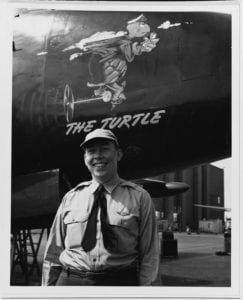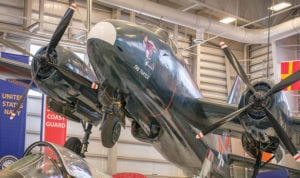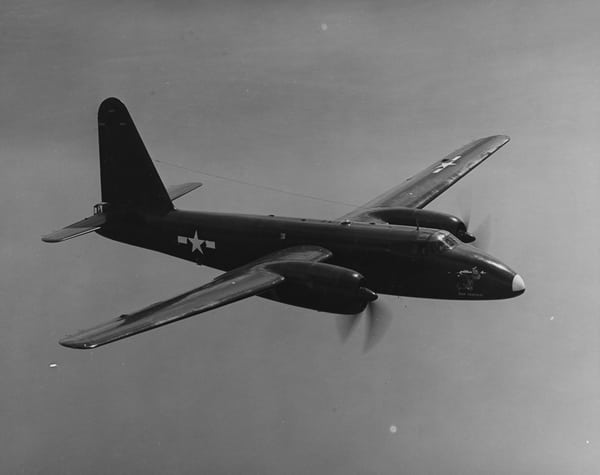The immediate post-World War 2 years for the US military were turbulent. While the US military branches were being dramatically downsized and restructured for new military realities involving the post-war Soviet Union, it was becoming apparent that long range bombing and patrol aircraft were going to be an integral military need going forward. With the the US Army Air Force being restructured into the US Air Force as a separate military branch, it was eager to prove that the B-29 Superfortress bomber could serve the United States’ strategic long range bombing and patrol needs. However, the US Navy, never a branch to concede its purpose and mission, wanted to prove that it too could provide a viable long range maritime patrol and bombing aircraft. Thus the battle of endurance and range began in 1946 with Admiral Nimitz eager to prove that the US Navy could exceed the Air Force’s capabilities. The story of the P2V Neptune The Truculent Turtle would be born.
THE P2V NEPTUNE
In 1946, the obvious choice of the US Navy for long range maritime patrol and bombing capabilities would be the new P2V Neptune aircraft. The Neptune was the first, and ONLY, plane in US Navy history designed for its specific purpose and produced to be used in wide US Navy service. Other planes before and after, including the P-3, were adaptations of planes designed for other purposes. Designed by Lockheed, the P2V Neptune provided ample crew and equipment space, and boasted a relatively long range. Thus, it was perfectly suited for a long distance flight challenge.
P2V NEPTUNE THE TRUCULENT TURTLE
The third P2V Neptune to roll off the Lockheed production line, Bu. No. 89082, was chosen by the US Navy to fulfill the bold challenge given by Fleet Admiral Chester Nimitz to the Secretary of the Navy to fly a naval maritime patrol aircraft from Perth, Australia to Washington, D.C., and even perhaps to Bermuda if the weather permitted. The stated purpose of the flight was to investigate extension of present patrol aircraft ranges, physiological limitations on patrol plane crews, and exploration of long-range navigation by pressure pattern methods. However, the clear unstated role of the flight would be to prove that the US Navy could be an equal torch bearer of strategic maritime patrol and bombing capabilities with the new US Air Force.
The P2V Neptune The Truculent Turtle was specially modified in order to enhance its operating range. Special Wright Cyclone engines were mounted, armament was removed, and multiple fuel tanks were installed in the bomb bay, fuselage and wings. Other modifications were made to increase operating endurance, such as adding an extra lubricating oil tank for the engines. Finally, JATO packs were attached to the plane to assist with takeoff. Commander Thomas D. Davies and co-pilot Commander Eugene P. Rankin would lead the flight. Commander Walter S. Reid and Lt. Cmdr. Roy H. Tabeling, plus a baby kangaroo, rounded out the crew.

Commander Thomas D. Davis – Pilot Of The Truculent Turtle
MISSION ACCOMPLISHED
At 6:11 pm on September 29, 1946, the P2V Neptune The Truculent Turtle prepared for departure from the Pearce Aerodrome in Australia near Perth, with a takeoff weight of 85,575 pounds. A record was already set by The Truculent Turtle! Up to that time, no twin engine aircraft had ever recorded such a takeoff weight. With JATO packs activated and engines at max power, the P2V Neptune The Truculent Turtle lumbered into the sky. Taking a path over the Indian Ocean into the Coral Sea and the Pacific, dawn of the second morning found The Truculent Turtle between Midway Island and Hawaii. Strong headwinds were causing a deviation from its planned “great circle route”. Compounding problems, powerful storms entered the The Truculent Turtle’s flight path, causing further navigation issues. As a result, the aircraft finally reached the US mainland near Northern California, rather than near Seattle as originally planned.
Dawn of the third day found The Truculent Turtle near Salt Lake City, Utah. Fuel was now becoming an issue given the previous wind and storms on the route. Thus, ultimately the aircraft was finally forced to land at 1:28 pm on October 1, 1946 at Naval Air Station Columbus, Ohio. Despite not accomplishing the goal of reaching Washington, D.C., the P2V Neptune The Truculent Turtle nevertheless accomplished a feat for the ages. Its long-distance flight record of 55 hours 17 minutes and 11,235.6 nonstop miles was not beaten until 1962 by a jet powered B-52 bomber. Furthermore, The Truculent Turtle’s record for a piston power aircraft was not beaten until 1986, when Burt Rutan’s carbon composite Voyager flew around the world non-stop.
THE P2V NEPTUNE THE TRUCULENT TURTLE TODAY
After a major publicity tour, The Truculent Turtle served as a test aircraft for aviation systems at the Naval Air Test Center in Patuxent River, Maryland. In 1953, the aircraft was displayed at Naval Air Station Norfolk, where it remained until its transfer to the National Naval Aviation Museum in Pensacola, Florida. Today, visitors can still see the miraculous “turtle that flew a marathon” at the Museum.

P2V Neptune The Truculent Turtle On Display At The National Naval Aviation Museum in Pensacola, Florida
FURTHER READING ABOUT THE TRUCULENT TURTLE
The Historic Flight of The Truculent Turtle – Maritime Patrol Assocation
Exhibit Story of The Truculent Turtle at the National Naval Aviation Museum

